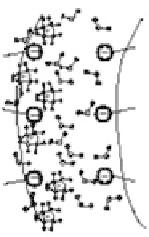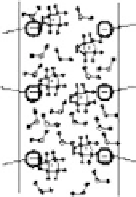Biomedical Engineering Reference
In-Depth Information
−+
−+
M
+
,H
2
O
−
+
FIGURE 16.6
Working principle of IPMC rest condition (
left
); bending due to activation (
right
).
corresponding metal atoms. According to described mechanism of activation, IPMC actuators usu-
ally operate best in a humid environment, even though they can be made as encapsulated devices to
operate in dry conditions.
Several applications of the bending function of IPMC actuators are currently being studied.
Some of them concern the biomedical fi eld in which the low-driving voltages required by this tech-
nology are particularly appealing. Within this ambit of application, a particular emphasis deserves
to be given to the following examples [42]. A concept for a ventricular assist device has been pro-
posed. It relies on the use of a few parallel IPMC bending units to be positioned around the heart
ventricles, as shown in Figure 16.7. The benders are arranged so that to provide a compression of
the ventricles, working as an assistance device.
A second type of concept under study consists of the development of a device proposed for sur-
gical corrections of refractive errors in eyes. In particular, the idea relies on the use of IPMC bands
to be positioned around the eyeball, as represented in Figure 16.8. The bands should be activated in
order to modify the length of the eyeball in the direction of the optical axis; accordingly, the related
corneal curvature should be exploited to induce refractive error corrections modulated by electrical
signals. This type of system is conceived as equipped with a built-in coil, which is remotely ener-
gized by magnetic induction, so that it provides power for the activation (Figure 16.8).
Other types of applications of IPMC actuators are being studied as well, including artifi cial
sphincters [42]. Nevertheless, for all these reported examples, it is worth stressing that from a
technological point of view, one of the most challenging issues still open concerns the necessary
improvement of the forces that an IPMC device can deliver. This is one of the main features that
concur at present to limit the applicability of these materials for several fi elds .
16.5 CONDUCTING POLYMERS
Conducting polymers are chemically characterized by the bond conjugation, that is, carbon double
bonds alternate with carbon single bonds along a polymer backbone. According to this feature,
they are typically identifi ed also as “conjugated polymers.” When doped with ions, these materials
can be characterized by high electrical conductivity values [43,44]. The conductivity of conjugated
polymers can be reversibly changed by orders of magnitude, by changing the doping level. Unlike
silicon, dopants can be easily inserted and removed from the spaces they occupy between the net-
works of the polymer chains. Moreover, in comparison with other semiconducting materials, the
doping level can be very high: approximately one dopant counterion per three or four monomers.
Depending on the doping level, different electrical properties can be obtained, spanning from
insulation, semiconduction, and conduction. Accordingly, conjugated polymers are being studied






















